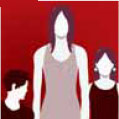 Large Medium Small
Large Medium Small7. One-child policy changed

China's top policymakers decided to relax the decades-long one-child policy at the Third Plenum of the 18th Central Committee of the Communist Party of China in November.
Couples are allowed to have two children if one of the parents is an only child, based on which provincial legislatures can make their own rules.
For instance, Beijing requires women to be over 28 or the second child should be born at least four years later than the first one, while Shanghai does not have such requirements.
Family planning was written into the Chinese Constitution in 1982 as an essential State strategy to prevent excessive population growth.
The government estimates that had the one-child policy not been introduced in the late 1970s, the Chinese population today would be around 400 million higher than its current level. In 2012, China's working population started to decline by 3.45 million annually, and after 2023, the working population is likely to fall by 8 million each year, according to the government.
The birth rate is relatively low and was showing signs of falling further. On average, since the 1990s, Chinese women of childbearing age give birth on average to 1.5 to 1.6 children.
In 2013, China had an aged population - people aged 60 and above - of 200 million, and in early 2030s, the aged population will reach 400 million, accounting for one-fourth of the total population.
"Now, the policy is only for qualified couples because China still has a large population. We can't handle too rapid population growth and too large a population now. It is not the time for all the couples to have two children. Pressure on our environment would be too heavy," said Zhai Zhenwu, an expert with the National Health and Family Planning Commission.